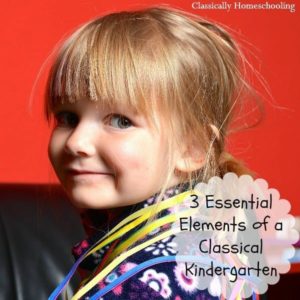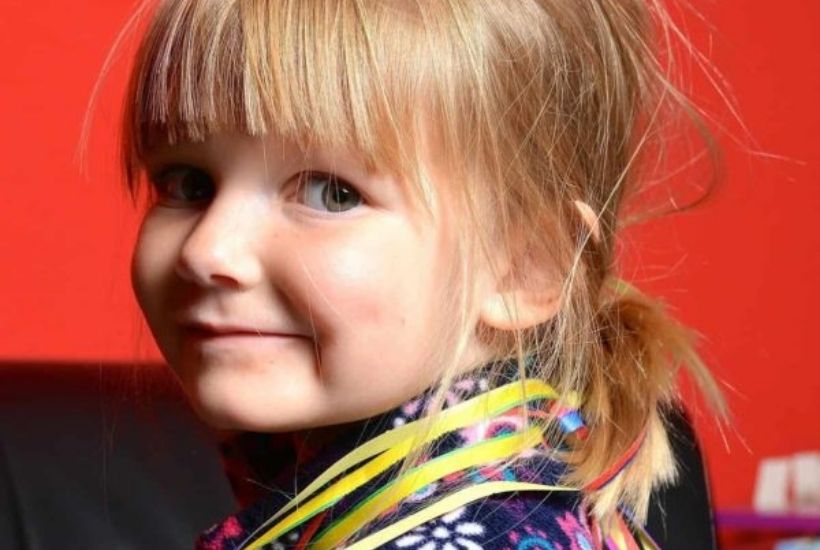The 3 Essential Elements of a Classical Kindergarten Homeschool
This post may contain affiliate links. For more information, please read my disclosure policy.
Essential elements of a classical kindergarten education
Teach the classical kindergartener in the homeschool is awesome. The little ones are bright, eager, and enthusiastic. They cheer when you say it’s time for school!
Over the years I’ve developed a kindergarten routine with my four oldest children. It has given me a few realistic expectations and a couple of goals for this year as my 5th child enters kindergarten.
Teach Reading
The first goal is to teach our children to read and to read well. We simply continue the phonics lessons we began in preschool. Phonics Pathways progresses slowly. I plan on taking 2 or more years to work our way through the book.
Eventually, long vowels are introduced, and I begin my kindergarteners on easy literature books such as the Bob Books or Dick and Jane Readers.
Handwriting
The second essential element of my classical kindergarten homeschool is beginning basic penmanship. We begin with writing single letters and progress to words.
By the end of the year, I like to see my child copying a sentence of 4-6 words. It gives us a good start for first grade when we will develop to copying full paragraphs.
There actually is a reason for copy work instead of free form writing. Copy work instills the basic rules of grammar, punctuation, and spelling in the child’s head.
The model sentence can come from books the child has read or a sentence the parent writes. Another technique is to have the child narrate a sentence while the parent writes it down. Then the child can copy their correctly written words neatly.
Math
Math is a third essential element of classical kindergarten education. I prefer to use Saxon Math K or Saxon Math 1 with my kindergarteners. Which one I choose, depends upon the child.
Some of my children thrive with 1st-grade math. Others need another year of solidifying basic counting and adding skills.
Keeping math informal and learning math through life skills works well at this age. Our kids are learning shapes, numbers, adding, subtracting, fractions, patterns, and puzzles. Daily practice is more important than the perfect curriculum.
Informal History, Science, and Art
Children in my classical kindergarten homeschool tag along with their older siblings in history and science. We complete read-aloud, listen to books, go on nature walks, and keep history and science low-key.
Learning to read, write, and do arithmetic is much more important. However history and science often inspire a love of learning, so we keep them light and fun but don’t skip the subjects.
Art is not neglected either. Finger painting and watercolors are two activities many children enjoy. The children are model with play dough, color with crayons, and enjoy many arts and crafts.
It’s also easy to turn the stereo onto a music station and introduce the child to various styles of music. This is also a great age to start dance or music lessons.
 Memory Work
Memory Work
Kindergarten is a wonderful time to begin the memorization of poetry, parts of speech, and types of animals. You don’t need to make an ordeal of memorization.
Simply repeat what you want your child to memorize 3 or 4 times at breakfast or lunch. They’ll be happily parroting you before you know it!
Remember:
Studies in the classical kindergarten homeschool don’t need to be dreary affairs that cause tears. Instead concentrate on the essential 3 elements of phonics, handwriting, and math. Pick a few fun activities and subjects to add to your day, and enjoy homeschooling your little one.
Recommended Reading:









This is a great post but may I dare to add a 4th essential? I think reading aloud to the kiddos as much as copy-work (even more when they are unable to read well) helps children to develop good grammar and an innate understanding of punctuation. I totally agree on the other subjects and that is exactly what we do they can sit with us during the studies and participate as much as they want before they go bounding into the backyard. Great Post 🙂
Thank you, and you’re absolutely right. Reading aloud is vital to help children learn to love books as well as developing grammar and punctuation skills. As reading aloud is part of our evening routine, I tend to think of it as part of my parenting rather than part of my homeschool. 🙂
Great essentials! My son is 5, so we are technically in this kindergarten year. My conundrum is that he was reading and writing very well last year, so I’ve moved him up to more 1st grade level things. Sometimes I fear that we do too much, but it’s only about 2 hours spread throughout the day (with some extra read aloud and other extras as we want to). If we are blessed with more children, I’m sure kindergarten will look different for them (more tagging along like you mentioned and focusing on the essentials). Thanks for sharing this post with us at Trivium Tuesdays!
2 hours spread throughout the day sounds perfect for a 5 year old. 🙂
Great post. I really enjoyed it. :o)
Thank you!
Great tips! I love the one about the child narrating a sentence to copy!
Thanks. 🙂
Another great post, thanks for sharing at Good Morning Mondays. Blessings
Thanks, Terri! 🙂
Great list! Our daughter is just beginning preschool but we are using an eclectic approach, with Classical education as a big part of it. I also like the part about narration. That is one of my favorite things about Charlotte Mason style schooling too. I might also add home economics and serving others. Our daughter loves helping cook and bake, which can easily be tied into science and math. Kids have so much to learn from household tasks too. So many learning opportunities and chances to serve others! 🙂 I look forward to reading more of your work. I found you at the Hip Homeschool Hop.
There’s a lot you can add into the homeschool! The problem quickly becomes how much is too much. 😉
Very true 🙂
Thanks, Kristi
Thanks Sara! I have looked back on this post several times now. A question about handwriting. Do you have suggestions for type/size of paper or lines vs. boxes for them to practice letters in? Any tips for Lefty Boys? Our 5 year old son knows each of his letters and I haven’t shown him “how” to write them yet, I just let him copy them.
Any suggestions would be helpful. Are you the one who suggested Handwriting without Tears to me? I don’t know if I need a “real” curriculum. Thinking just copywork and practice on paper of some kind would work?
Hi Amy! I think I did suggest Handwriting without Tears. I actually prefer start teaching with Handwriting without Tears‘ slate and chalk. You can use it to write single letters or even to move up to words. It doesn’t matter how messy the writing is, you just erase and try again. 😉 My youngest, also in kindergarten, doesn’t like writing on paper so we use the slate.
I’ve not actually taught a lefty although it took several years for one child to settle on writing with his right hand. I just insisted he hold the pencil and form the letters correctly. Otherwise I didn’t stress about which hand he chose to write with.
And no, you don’t need a ‘real curriculum’. Copywork and practice on paper is all that’s needed. Slates are useful for teaching letter formation though. Otherwise we use up a lot of paper practicing basic penmanship. I adore this paper. Tall letters start at the sky and come down to the ground. g, p, y, etc. start in the middle and sink into the ground. The colors make it so much easier to teach proper penmanship. You don’t need it though. Writing can be taught just as easily on blank or wide ruled paper. 🙂